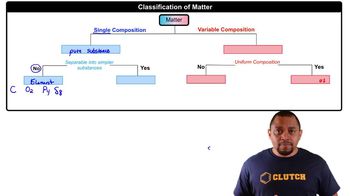An acid solution is 0.100 M in HCl and 0.200 M in H2SO4. What volume of a 0.150 M KOH solution would completely neutralize all the acid in 500.0 mL of this solution?
The nitrogen in sodium nitrate and in ammonium sulfate is available to plants as fertilizer. Which is the more economical source of nitrogen, a fertilizer containing 30.0% sodium nitrate by weight and costing $9.00 per 100 lb or one containing 20.0% ammonium sulfate by weight and costing $8.10 per 100 lb?
 Verified step by step guidance
Verified step by step guidance
Verified video answer for a similar problem:
Key Concepts
Percentage Composition

Cost-Effectiveness

Molar Mass and Stoichiometry

Find the mass of barium metal (in grams) that must react with O2 to produce enough barium oxide to prepare 1.0 L of a 0.10 M solution of OH-.
A solution contains Cr3+ ions and Mg2+ ions. The addition of 1.00 L of 1.51 M NaF solution causes the complete precipitation of these ions as CrF3(s) and MgF2(s). The total mass of the precipitate is 49.6 g. Find the mass of Cr3+ in the original solution.
Find the volume of 0.110 M hydrochloric acid necessary to react completely with 1.52 g Al(OH)3.
Treatment of gold metal with BrF3 and KF produces Br2 and KAuF4, a salt of gold. Identify the oxidizing agent and the reducing agent in this reaction.
Treatment of gold metal with BrF3 and KF produces Br2 and KAuF4, a salt of gold. Find the mass of the gold salt that forms when a 73.5-g mixture of equal masses of all three reactants is prepared.
